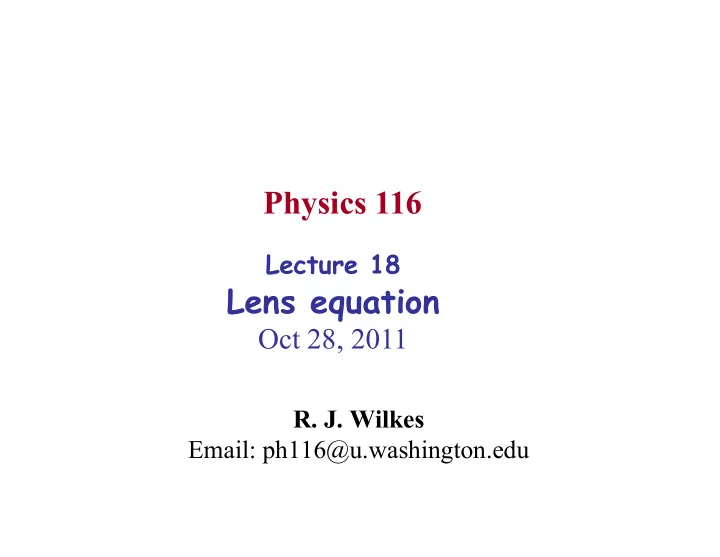

Physics 116 Lecture 18 Lens equation Oct 28, 2011 R. J. Wilkes Email: ph116@u.washington.edu
Announcements • � Today’s Guest Lecturer: Kevin Connolly • � JW will be back Monday
Lecture Schedule (up to exam 2) Today 3
Ray tracing applet – try it yourself http://silver.neep.wisc.edu/~shock/tools/ray.html (original source http://webphysics.davidson.edu/Applets/Optics4/Intro.html)
examples • � Lead glass has n=2.0 – � What is the speed of light in this glass? – � What is the critical angle for total internal reflection for a light ray going from lead glass to air? – � What is the Brewster angle for polarizing light reflected off a lead glass surface? At this angle of incidence, Reflected ray is polarized reflected rays are 100% polarized 63° Brewster angle example: Critical angle example: n 1 = 1.0 n 2 = 1.0 Ray is traveling downward n 1 = 2.0 n 2 = 2.0 At greater angles, rays are 100% 30° Ray is reflected traveling upward
Ray tracing rules -> lens equation • � We can use geometry to get an algebraic lens equation from our ray tracing rules: object 1 3 f o o 2 o Focal pt Focal pt image Object distance Image distance
A pinhole is a lens! • � A pinhole acts like a lens with a long focal length – � If pinhole is too wide, too many ray angles get into the camera, make the image a blur • � Use a pinhole camera to view the sun (eg, check for sunspots) object f o image Object distance Image distance From http://en.wikipedia.org/wiki/Pinhole_camera and http://www.kodak.com/global/en/consumer/education/lessonPlans/pinholeCamera/
Examples Camera lens is adjusted to have f=28mm. Film is 50mm behind it. • � At what distance in front of the lens will objects appear in focus in the image? – � We know f and d I , and want to find d O : We want to project an object 35mm tall onto a screen 600 mm away, and have the image be 10 times bigger. What lens do we need, and where to put it in front of the object? – � We know d I , h O and h I , and want to find d O and f : but m relates d O to d I
Examples three parallel beams of light arriving on a transparent sphere as shown. • � They converge at the back surface of the sphere. What is the refractive index n for the sphere? – � Find refraction angle ! 2 : the yellow triangle is equilateral, so Such a high index means it is probably not glass – could be a mineral like sapphire or garnet. If it were diamond (n=2.42) where would the beams meet? Notice it is impossible to focus the beams at the center of the sphere that would require ! 2 = 0 for finite ! 1
Examples Two lenses glued together form a “contact doublet”. If the lenses are thin, we can use • � the lens equation and assume they are both at the same x. What is the focal length of the doublet, given the f’s of the lenses ? – � Find the location of image for lens 1 and treat it as the object distance for lens 2 – � d O2 has to be considered negative since it is behind lens 2 – � Apply the lens eqn to find d I2 , and again to find the effective f of the doublet – � Notice: in diopters, the refracting power of the doublet is just the sum of the lens powers!
Chromatic aberration: rainbows from lenses • � Index of refraction n=n( " ), so refraction angle depends on color – � " =wavelength, usually given in nanometers (nm) • � 1 nm =10 -9 m = 0.001 micron ( # m), 10 angstroms (Å) • � center of human visual range ~550 nm=0.55 # m=5500 Å – � For most materials, n decreases with increasing " • � so n BLUE > n YELLOW > n RED and we get different focal pts for different colors: F R F B F Y F R - F B = CA (Chromatic Aberration) We’ll come back to this in Ch. 28: Not On Exam 2! 11
Rainbows, Halos, etc • � Rainbows come from the refraction of sunlight in round water droplets (round prisms) – � preferred one-bounce reflection path has ~42° deflection angle – � rainbow arc always centered on anti-solar point (opposite direction to sun) – � different colors refract at slightly different angles, as in glass prism • � Caused by differences in refractive index of water for different colors (wavelengths) single bounce; red & blue paths different red appears higher in bow than blue 12
Rainbows come in pairs… • � Rainbows have multiple orders corresponding to number of reflections in raindrop: 2 nd -order bow appears at 51 degrees: Secondary rainbow has two reflections. Red now appears lower than blue in the sky. Higher orders cannot usually be seen. The primary bow is brighter, and the color sequence is reversed in the much-fainter secondary. Secondaries are best seen when rain is heavy while sunlight coming from behind you is bright 13
Clicker quiz • � A material’s index of refraction [only one is correct] A. � Is 1.0 for all materials, since the speed of light is c everywhere B. � Is a measure of the transparency of the material C. � Is greater than 1.0 for all materials D. � Represents the density of the luminiferous ether inside the material
Recommend
More recommend